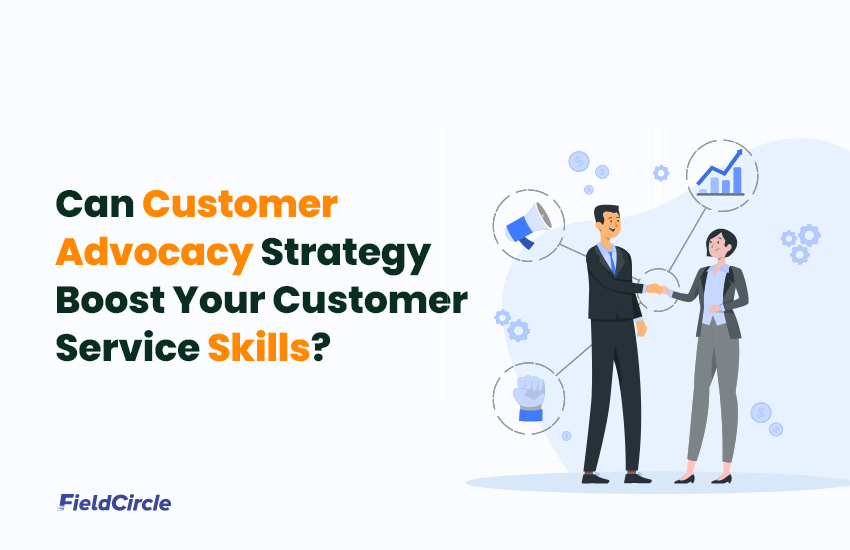Can Customer Advocacy Strategy Boost Your Customer Service Skills?

Field service industries, encompassing various businesses from HVAC services to construction and maintenance, rely heavily on building and maintaining strong customer relationships. In this context, customer advocacy refers to turning satisfied customers into vocal advocates for your business. These advocates sing your praises and refer new customers, acting as invaluable brand ambassadors. A report by Nielsen on advertising found that 92% of consumers trust recommendations from friends and family, while 70% trust online consumer reviews.
Customer advocacy aims to create new customers by going above and beyond while utilizing existing customers and offering various resources. These are just a few examples of how customer advocacy programs work. Customer advocates develop innovative strategies to attract more customers and ensure their satisfaction.
So, who is responsible for customer advocacy? The answer is your satisfied clients. Customer advocates focus on making businesses more customer-oriented by considering everything from a customer’s perspective, including products, shopping, returns, payments, deals, and incentives. They speak on behalf of the customers and to the customers.
In this blog, we will explore the significance of customer advocacy in field service and how it can propel your business toward growth and success. Additionally, we’ll delve into the first step, understanding your customer’s needs, a vital foundation for building effective customer advocacy programs.
Understanding the Client’s Needs is the Essence of Customer Advocacy
Specifically, in the services industry, where trust and reliability are paramount, feedback from your satisfied clients can be the differentiator that sets your business apart from the competition. Understanding your customer’s needs is fundamental in building customer advocacy and delivering outstanding service in field service industries. This understanding is crucial for building a solid customer base, anticipating their requirements, and tailoring your services to meet their expectations. Here are some ways in which understanding your client’s needs helps you in creating a solid customer advocacy program:
· Elevating Service Quality:
In the field service industry, gathering customer feedback serves as a valuable resource for pinpointing areas needing service enhancement. Through proactive collection and analysis of feedback, you can continually refine your operational processes to better align with your customer’s requirements.
· Boosting Customer Satisfaction:
When your customers perceive that you genuinely value their feedback and take actionable steps in response, their satisfaction levels rise. This nurtures a positive perception of your services and can lead to advocacy and positive word-of-mouth recommendations.
· Identifying Operational Challenges:
Customer feedback within the field service sector assists in the recognition of operational challenges and pain points in their service experiences. Addressing these issues promptly can mitigate potential technical or service-related problems before they escalate and negatively impact client relationships.
· Fostering Service Innovation:
Valuable customer input can catalyze innovation within your service offerings. It yields insights into the desires and expectations of your customers, enabling you to develop novel services that align with their evolving needs and preferences.
When your customers become advocates, they stick with your services and actively promote them, enhancing your reputation and trustworthiness in the market. This, in turn, can lead to increased revenue, higher customer retention rates, and more significant business success.
Strategies for Encouraging Customer Loyalty in Field Service
This is paramount for a service provider of this sector to encourage customer advocacy through strategies such as customer referral programs, reviews and testimonials, and rewards for loyal customers is vital for your business. It drives organic growth, strengthens your reputation, and fosters a customer-centric culture that can differentiate your business from competitors. Happy customers who become advocates are among your most valuable assets, and nurturing this advocacy is vital to long-term success. Here are some strategies that can encourage customer advocacy
1. Implementing a Customer Referral Program:
Customer referrals are cost-effective and result in high-quality leads, which can help build trust and establish a positive relationship. It also incentivizes your satisfied customers to refer new clients to your business. This strategy involves:
· Offering rewards or incentives to customers who refer others, such as discounts, credits, or free services.
· Creating a straightforward referral process that is easy for customers to participate in.
· Promoting the program through various channels to ensure that customers know it.
2. Requesting and Promoting Customer Reviews and Testimonials:
Positive reviews and testimonials can be powerful tools for building customer advocacy. These strategies help your business by serving as social proof of your quality and trustworthiness. Positive reviews can enhance your online visibility, manage your online reputation, and increase your credibility and authority in the market. To encourage them:
· Actively ask satisfied customers to leave reviews on platforms like Google, Yelp, or your website.
· Showcase these reviews and testimonials on your website and marketing materials to build trust and credibility.
· Consider thanking customers who provide reviews with small tokens of appreciation.
3. Rewarding Loyal Customers for Their Advocacy Efforts:
Rewards for loyal customers reinforce their advocacy, encourage long-term support, increase retention, and amplify advocacy by expanding your reach and impact. Loyal customers can be a goldmine of advocacy potential. To nurture their advocacy:
· Create a loyalty program that offers exclusive rewards and benefits to long-term customers.
· Recognize and reward loyal customers who refer new clients or promote your brand.
Gathering Feedback from Satisfied Field Service Clients
Gathering feedback from clients is essential to determine their likelihood of becoming advocates. Here are a few ways to gather client feedback:
· Surveys and Questionnaires:
You can develop and distribute surveys or questionnaires to systematically gather structured customer feedback. These surveys can be administered via email, your website, or social media platforms. You can additionally send out an online survey to customers after each service appointment to assess their satisfaction and identify areas for improvement, such as technician punctuality and service quality.
· Interviews and Focus Groups:
Collecting customer insights through in-person or virtual interviews, webinars, and focus groups provides a personalized approach. These interactions facilitate deep conversations and help gain a profound understanding of your existing or potential customer preferences. Discussions with business clients can help you understand their specific needs, leading to tailored service solutions.
· Social Media Monitoring:
Closely monitoring social media platforms for mentions, reviews, and comments about your services can offer real-time insights into customer sentiment. For example, a company can actively track social media channels to gauge customer satisfaction levels and promptly respond to client complaints or issues, ultimately enhancing its online reputation.
· Customer Support Interactions:
Customer support interactions, whether over the phone, through email, or via chat, present a valuable opportunity to gather insights into customer needs, concerns, and feedback. For instance, a field service organization specializing in IT support can use data from customer support calls to identify recurring technical issues and common challenges clients face, leading to targeted service improvements.
· Data Analytics:
Players in this industry can harness data analytics tools to collect and analyze customer data, encompassing aspects like purchase history, website interactions, and preferences. This can offer insights into customer behavior and preferences. For example, service providers in the home maintenance sector can utilize data analytics to analyze customer behavior on their website. They can identify the most sought-after services and peak booking times, allowing for more efficient resource allocation and tailored marketing campaigns.
Customer data gathered can be effectively utilized to create personalized experiences. The customer experience can further be accentuated by offering tailored product or service recommendations. Leveraging predictive analytics in customer service, businesses can anticipate customer needs more accurately—for example, vendors can proactively schedule maintenance based on historical data. Customers can be segmented into groups with similar preferences to refine services and marketing, thereby increasing relevance. Additionally, customer feedback can be incorporated into continuous improvement efforts, demonstrating your dedication to meeting their needs through responsive enhancements.
How to Empower Field Service Technicians to Increase Customer Satisfaction
Technicians are critical in shaping customer experiences in the facilities industry. Their customer interactions can significantly influence whether a customer advocates for your business. When technicians are equipped with the right tools, prioritize their customers’ needs, and go above and beyond to enhance their field service customer satisfaction and loyalty. These satisfied individuals later become brand advocates of your product and services, contributing to a strong brand strategy by spreading positive word-of-mouth about your services and ultimately driving referrals. Here are three key factors to consider when empowering technicians to increase customer advocacy:
1. Training Technicians to Prioritize Customer Satisfaction:
To ensure technicians elevate their customer journey, they need appropriate training and guidance. This can involve:
· Customer Service Training: Equip technicians with training emphasizing active listening, empathy, and effective communication. They should understand the importance of solving technical issues and ensuring the customer feels valued.
· Conflict Resolution Skills: Provide training in conflict resolution and problem-solving techniques. Technicians should be able to handle challenging situations with grace and professionalism.
· Service Standards: Define clear service standards and expectations for technicians. Make sure they understand what excellent customer service looks like in your organization.
· Feedback and Continuous Improvement: Encourage a culture of feedback and improvement. Regularly collect feedback from customers about their service experiences and use this feedback to refine technician training and performance.
2. Providing Tools and Resources to Improve Customer Interactions:
Equipping technicians with the right tools and resources can significantly enhance their ability to interact with customers effectively. Consider the following strategies:
· Technology and Software: Provide technicians with access to user-friendly mobile apps or software that enable them to access customer information service histories and communicate with customers efficiently. This helps technicians offer a more personalized service.
· Knowledge Base: Create a comprehensive knowledge base or database of common issues and solutions that technicians can reference. This helps them address customer questions or concerns more effectively.
· Communication Tools: Offer communication tools, such as smartphones, tablets, or field service management software, that allow technicians to keep customers informed about their service appointments, arrival times, and work progress.
· Customer Feedback Mechanisms: Implement systems for collecting immediate feedback from customers after a service call, allowing technicians to gauge their performance and make improvements.
3. Encouraging Technicians to Go Above and Beyond for Customers:
Encouraging technicians to go the extra mile for customers can lead to stronger customer advocacy. Here’s how to foster this mindset:
· Recognition and Rewards: Recognize and reward technicians who consistently deliver exceptional service. This can include monetary incentives, performance bonuses, or organizational public recognition.
· Customer-Centric Culture: Cultivate a customer-centric culture within your field service organization. Encourage technicians to view their role as more than just fixing equipment; they are there to provide solutions that improve the customer’s overall experience.
· Empowerment: Empower technicians to make decisions that benefit the customer. Give them the authority to offer discounts or complementary services within predefined limits, so they can resolve issues without needing managerial approval.
· Regular Communication: Have open and regular communication channels between technicians and management. Encourage technicians to share customer feedback, challenges, and ideas for improvement and take their input seriously.
Evaluate Continuously to Improve Customer Advocacy
In the current industry scenario, it is crucial to continually evaluate and improve customer advocacy to maintain strong customer engagement and ensure long-term business prosperity. By adjusting customer advocacy strategies to align with evolving customer expectations and market dynamics, you can establish customer loyalty and encourage customers to become active advocates of your services, eventually leading to growth and enhancing your market reputation. This vital process guarantees the effectiveness and adaptability of your efforts to build and foster robust customer relationships. Here’s how it works:
· Monitoring Customer Satisfaction Metrics and KPIs:
Tracking customer loyalty metrics such as Net Promoter Score (NPS), Customer Satisfaction Score (CSAT), and Customer Effort Score (CES) enables you to assess the effectiveness of your customer advocacy strategies. This, in turn, provides you with quantifiable insights into customer success and plays a crucial role in understanding how to get repeat customers. Regularly monitoring these metrics helps identify any evolving trends in the customer experience. If there are sudden declines or significant shifts in these metrics, this signals areas that require immediate attention. These metrics offer valuable data for decision-making purposes. Analyzing this data empowers you to make informed adjustments to your strategies, thereby addressing specific pain points that hinder customer advocacy.
· Conducting Regular Customer Surveys to Identify Areas for Improvement:
Customer surveys are an invaluable tool for businesses to gather direct customer feedback. Surveys provide customers with a platform to express their thoughts, concerns, and suggestions, allowing businesses to understand their customers’ needs and preferences better. Moreover, surveys help businesses identify precise pain points and areas where customers experience dissatisfaction or frustration. Addressing these issues could lead to significant improvements in customer advocacy. Surveys also enable businesses to compare their performance over time and against industry benchmarks, facilitating the tracking of shifts in customer sentiment and ensuring competitiveness in a dynamic market.
· Implementing Feedback Loops and Integrating Customer Suggestions:
One of the keys to ongoing improvement is the use of feedback loops. Collecting customer suggestions and incorporating them into your practices demonstrates your commitment to fostering customer loyalty and advocating for their needs. Engaging customers through feedback loops establishes a sense of partnership and involvement, signaling that their input holds significance and that you are responsive to their concerns. Proactively addressing customer suggestions and concerns prevents issues from escalating, ultimately resulting in improved customer experiences and heightened advocacy. Additionally, customer suggestions can serve as a source of innovation. By attentively listening to customer ideas and recommendations, you can uncover novel ways to meet their needs and maintain a competitive edge in the field service industry.
Elevate Customer Skills to Win Loyal Customer Advocates
In today’s highly competitive and ever-changing market, delivering a delightful customer experience is essential to achieve top-notch customer advocacy for your business. As Steve Jobs famously said, “Get closer than ever to your customers. So close that you tell them what they need well before they realize it themselves.” You need more than a competitive edge to convert your clients into local advocates. To provide your customers with an improved experience, implementing field service management software can help you achieve more efficient, transparent, and profitable field service operations.
If you want to know more about how you can provide your customers with an improved field service, schedule a demo with our experts today!


